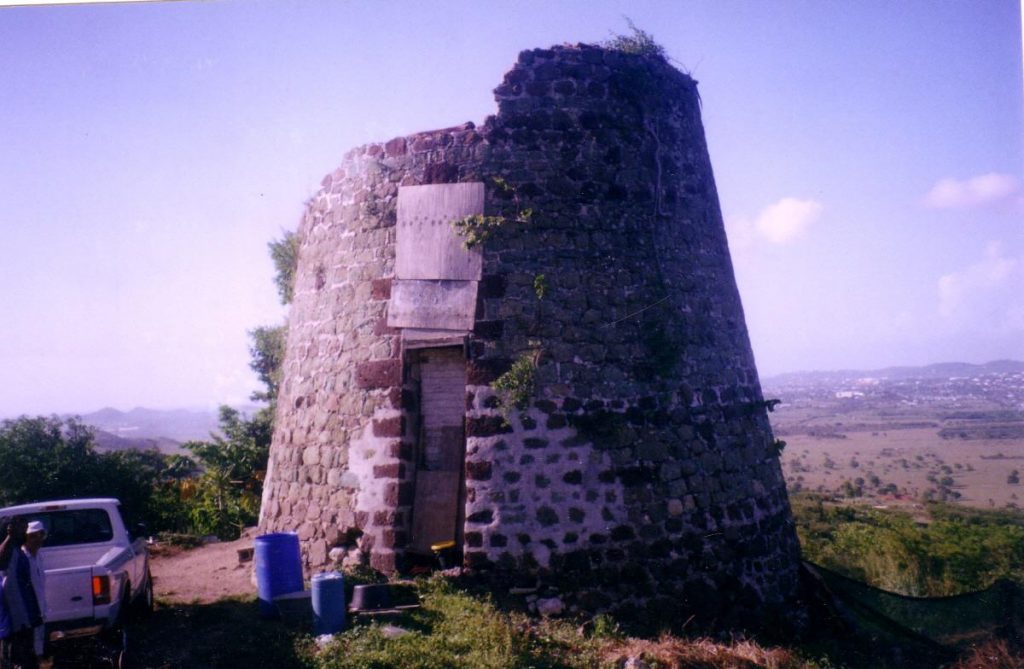About
Type: Extant
Parish: St.John
Founding date: 1668
See on Google Maps!

Current Status
A stone above the sugar mill’s doorway bears the inscription “CFS 1732”. The initials remain a mystery; could be attributed to the builder. The mill is crumbling at its top but was converted to two levels in the 1990s to house Nigel Lee’s Family. It has a wonderful view of the Bendal’s Valley, and the current owner, Nigel Lee, has tilled the soil to provide a prolific garden.
Estate Related History/Timeline
There were Gilliat families in both Antigua and Jamaica. Three hundred years of history on the web provided the author with the following: Chris Codrington, who has researched his own prominent family (see Clare Hall #13b), which had some family connections with the Gilliats of Jamaica. Mr. Coddirngton says his research showed that there were family connections with the Gilliats of Jamaica. Samuel Gilliat, born in 1717 at Crowie, in Lincolnshire, may have been the first, although Anthony Gillyat (sic), born March 9, 1644 at South Ferriby, is also thought to have relocated to Jamaica. (The two spellings of the last name reflect the birth registrations.) A daughter, Lucy Gilliat, was born in 1647, also to Anthony Gilliat of South Ferriby. The two villages, Crowie and South Ferriby are close geographically and border the Humber River.
Mr. Coddrington could find no further record of the Gilliat family in the UK, so it is possible they had left the country. Assuming Anthony Gilliat, born in 1644, is the same individual who owned Halliday’s Mountain in 1668, he would have been 24 years old. It may have been his father. 300 years of Gilliat History, Public Records, Kew, London.
The name Halliday does not appear on a 1933 map of Antigua, but it is the name best known by residents of the Bendals/Greencastle area. The family figured prominently in the history of Scotland, County Galloway, since the sixteenth century. John Halliday, a collector, was born in Antigua and was a nephew of William Dunbar (see Boone’s #1) and son-in-law of Francis Delap.
“James Halliday of Antigua, signed the Capitulation to the French in 1666, his 1,400 acres reduced to 800 in 1668. In 1780 John Delap Halliday was rated on 300 acres, 137 slaves (St. Mary’s Vestry Book). In 1788 John Delap Halliday owned the following plantations Blizard’s (#54); in St. Paul’s Parish — Delaps (#137) and Rockhill; and one un-named in St. Mary’s Parish: in St. John’s Parish — Boone’s (#1), Gamble’s (#14) and Blizard’s (#54); in St. Philip’s Parish — Laviscount’s.
“Halliday Hill, which was another popular hill to climb, was best known for its history regarding slave masters who would put slaves in barrels and roll them to their deaths. In that area was also Warner plantation which held a significant interest in the land because some slaves started a rebellion there during the last years of slavery. Aunt Dood, quoted in Keithlyn Smith’s “Symbol of Courage”.
“We found Mr. Martin at the Church door with our carriages, into which we mounted and were soon at Mr.Halliday’s Plantation, where he this day dined; for he has no less than five, all of which have houses on them. We had a family dinner, which in England might figure away in a newspaper, had it been given by a Lord Mayor for the first Duke in the kingdom. Why should we blame these people for their luxury? Since nature holds out her lap, filled with everything that bestows, it was sinful to them not to be luxurious. “They never make but two, the soup and the shell. The first is commonly made of old Turtle, which is cut up and sold at the Market, as we do butcher meat. It is remarkably well-dressed today. The shell, indeed, is a noble dish as it contains all the fine parts of the Turtle baked within its own body, here is the green fat, not the slabbery thing my stomach used to stand at, but firm and more delicate than is possible to describe.” Journal of A Lady of Quality.
Documents relating to John Halliday’s Antigua estates 1777-1857 are held by Cheshire Archives and Local Studies.
In 2009, this mill was hidden by bush and basically forgotten until Nigel Lee leased the land from the Government in the 1990s. He was told the designation for the cane field was No. 7, but never knew the actual name of the plantation or mill. His goal is to repair the sugar mill entirely.
Enslaved People’s History
Based on contemporary research, we have little information to share about the enslaved peoples from this plantation at this time. They probably had a maximum of 137 people working at that plantation. “Halliday Hill, which was another popular hill to climb, was best known for its history regarding slave masters who would put slaves in barrels and roll them to their deaths. In that area was also Warner plantation that held a significant interest in the land because some slaves started a rebellion there during the last years of slavery.” Aunt Dood, quoted in Keithlyn Smith’s “Symbol of Courage,” We will continue our quest for more information about these vital individuals.
Ownership Chronology
- 1668: Anthony Gilliat, a planter. 38 acres in Popeshead estate
- 1719: Thomas Gilliat. Will: 1714
- 1740: Joshua Gilliat d. 1791, in Jamaica
- 1750: John Halliday. (1717c-1779) 300 acres, 137 slaves.
- 1777: John Delap Halliday (1777/78 map by cartographer John Luffman.)
- 1872: Fryer’s Concrete Co
- 1933: James John (1933 Camacho map.)
- 1940’s: Antigua Syndicates Ltd
- 1990’s: Nigel Lee, leased the land around the mill (cane field #7) from the government